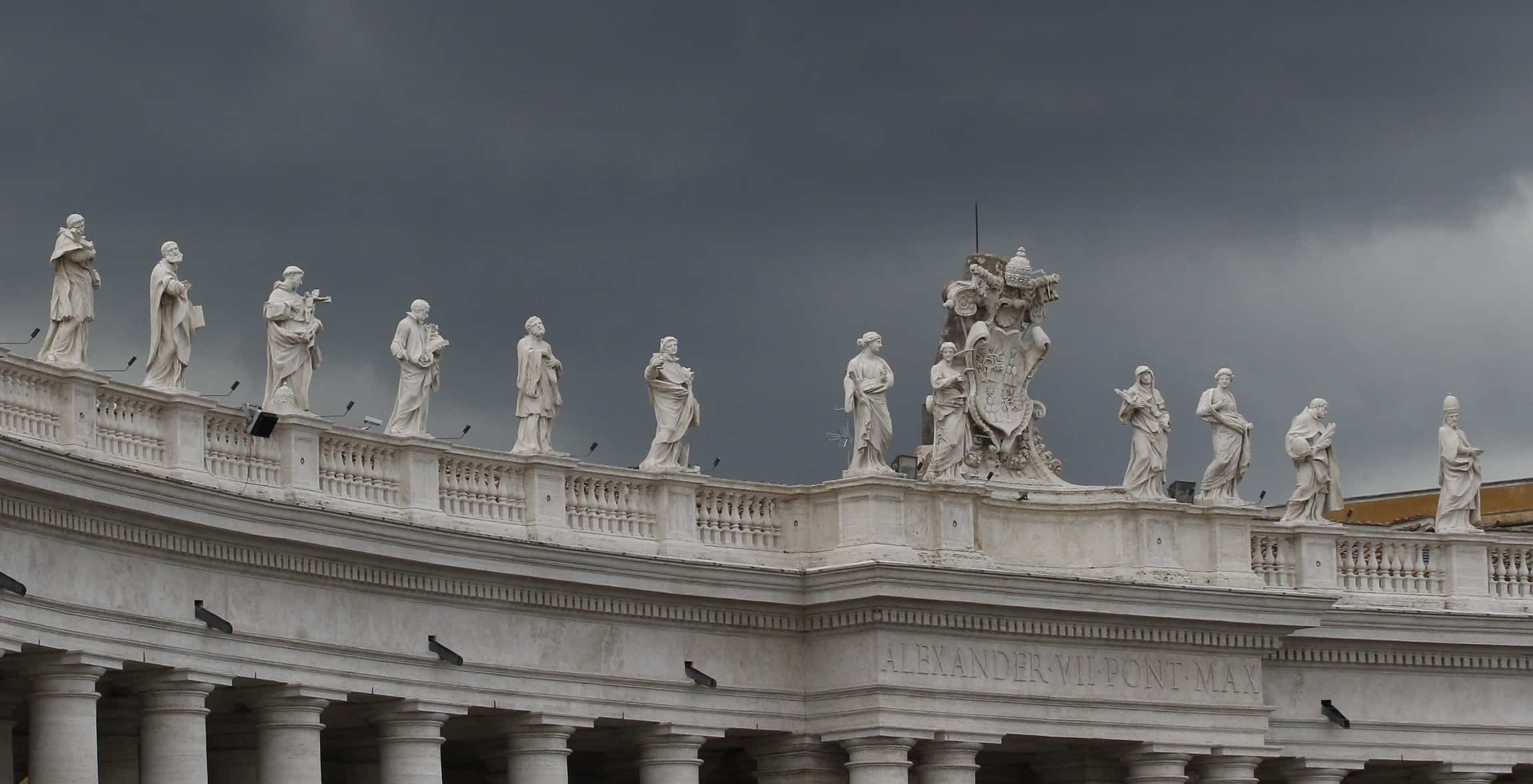When people argue about Pope Francis, how often are they really disagreeing on more fundamental issues – like the nature of the Church and who is Jesus Christ?
Last Wednesday night, Ross Douthat and Massimo Faggioli, two well-known Catholic public intellectuals, engaged in a public discussion looking at the first five years of the Francis papacy. To those unfamiliar with these men, they often represent two different parts of the spectrum of American Catholicism. Faggioli is a theologian at Villanova who has written extensively on Vatican II and who often is seen as a spokesman for a more progressive Catholicism; Douthat, who regularly writes opinion columns for the New York Times and who has written several books critiquing American culture, is seen as a similar spokesman for a more traditional Catholicism. Though their public meetings had previously consisted in pithy—and sometimes heated—exchanges on Twitter, the conversation they had in person at Fordham University was, to my eyes, one of depth and real seeking after truth.
To try to rehash the whole conversation in this piece would be too much, so I hope to offer instead a glimpse of what I took to be the heart of their disagreement and common concern. To that end, one might be surprised that the event, “Francis@Five,” wound up being only partially about Francis. The topic that seemed to take center stage was really Vatican II. Francis was a recurring topic but both men seemed to come back to a central question: how does the Church understand Vatican II and its documents?
Both men acknowledged that Vatican II called for a shift in the ways the Church thought about and interacted with the larger world. However, they also both acknowledged that the current conflicts in the Church—especially those in the American Church—stem from divergent interpretations of what exactly shifted and to what extent. There appear to be at least three different main interpretations.
First, there is the view in which Vatican II means that the Church ought to dialogue with external voices—secular and interreligious voices—and accept that the Spirit might call for the Church’s traditions to continually be shaped anew and transformed by that ongoing dialogue. From this perspective, even Church teachings on moral issues might be significantly changed through engagement with modernity. This position is most common among more progressive Catholics.
Second, there is what Douthat called the John Paul II synthesis, in which Vatican II called for dialogue, but one in which the firmness of most of the Church’s teachings acts as a witness to those with whom it dialogues. Here there is room for change and growth in response to modernity–on some aspects of interfaith dialogue, or the historical investigations of scripture, for instance–but there is also a strong sense that the Church’s moral teachings stand as a sign of contradiction to the world’s values.
If this second interpretation is more traditional, there is a third position that goes a step further. When asked to characterized those in the Church who oppose Francis, Douthat suggested that there is a growing group that has come to see Vatican II largely as a mistake by either of those interpretations. As he put it, if the John Paul II synthesis paved the way for Francis’ raising questions even about issues of marriage and sexuality, then that is to them a sign of the failure of the John Paul II synthesis and so calls into question the legitimacy of Vatican II. On this interpretation, there seem to be few areas in which the Church can change in response to modernity.
The three interpretations of Vatican II seem to me to ring true as far as generalizations go, and I think it crystallizes the point at issue: if the discussion stays at the level of Amoris Laetitia or any one controversial issue, those in disagreement will continue to talk past one another. The conversation must get to the question of how we are to understand the Church, its traditions, and the ways they can and possibly cannot develop.
Here it appears to me that Faggioli and Douthat have different understandings of the Church and its role in the world, as evidenced by the way they spoke at this event. For Faggioli, the Church is a living organism whose purpose is continually growing closer to Christ. ‘Growing,’ is the key term here, and Faggioli rejects the framework—used especially by Pope Benedict XVI—of continuity and discontinuity as unhelpful if we think of the Church as organism. Though he did not really explain how we can dispense with this frame without completely opening every aspect of tradition to discussion, he seems to hold that the Church, like an organism, must continue to respond to the needs and problems of its environment. On this model, he thinks, even significant changes need not be seen as ruptures.
Douthat, on the other hand, seemed to refer to the institutional Church when he used the word; if he did not specifically mean the ecclesiastical hierarchy, he at least seemed to emphasize the magisterial role of the Church as teacher. From his emphasis on synthesis, it seems he believes the Church needs to have clear teachings that hold to absolutes. Pastoral flexibility cannot risk calling these principles of the divinely-instituted moral law into question without undermining the Church’s role. Several times Douthat questioned the “endgame” of certain changes called for by those supportive of Francis, whether they are just first steps to more radical changes—and implying that there are points beyond which the Church cannot go.
This questioning of what the Church is goes even further, though. Ultimately, it is a question about who Christ was—and this came up in discussing his reaction to the Samaritan woman at the well. Do we understand him as having been willing to relax a moral absolute for the sake of pastoral care, or do we see him as having cared for her within the framework of that moral absolute? This seems a key question underlying the discussions of Church, tradition, and Vatican II.
These are questions we Catholics will have to keep working to answer together. As both men pointed out, it took the Council of Trent at least a hundred years to sink in; we are only about fifty years out from Vatican II. We may hope that time will lead to greater unity. We may not, as Douthat pointed out, take that unity as inevitable. The Church’s history is marked by conflicts, schisms, and civil wars.
Still, I do not think we should be afraid. Love casts out fear, and love in the form of charity will guard us against the animosity that turns disagreement into schism. Such charity remains, despite significant differences, and it was visible last week in two men who both care deeply about the future of the Church.


